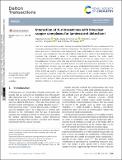Interaction of N-nitrosamines with binuclear copper complexes for luminescent detection
Author(s)
Feng, Haosheng; Luo, Shao-Xiong Lennon; Croy, Robert G; Essigmann, John M; Swager, Timothy M
DownloadPublished version (2.690Mb)
Publisher with Creative Commons License
Publisher with Creative Commons License
Creative Commons Attribution
Terms of use
Metadata
Show full item recordAbstract
Cu(I) from tetrakis(acetonitrile)copper(I) hexafluorophosphate ([Cu(MeCN)4]PF6) was complexed with five structurally related phosphines containing N-heterocycles. The interactions between the resulting complexes and some N-nitrosamines were studied using X-ray crystallography as well as emission spectroscopy. Upon complexation, three phosphine ligands bridge two Cu(I) centers to give paddlewheel type structures that displayed a range of emission wavelengths spanning the visible region. N-Nitrosodimethylamine (NDMA) was shown to coordinate to one of the two copper centers in some of the paddlewheel complexes in the solid state and this interaction also quenches their emissions in solution. The influence of the weakly coordinating anion on crystal and spectroscopic properties of one of the paddlewheel complexes was also examined using tetrakis(acetonitrile)copper(I) perchlorate ([Cu(MeCN)4]ClO4) as an alternative Cu(I) source. Similarly, copper(II) perchlorate hexahydrate (Cu(ClO4)2·6H2O) was used for complexation to observe the impact of metal oxidation state on the two aforementioned properties. Lastly, the spectroscopic properties of the complex between Ph2P(1-Isoquinoline) and Cu(I) was shown to exhibit solvent dependence when the counterion is ClO4−. These Cu(I) complexes are bench stable solids and may be useful materials for developing a fluorescence based detection method for N-nitrosamines.
Date issued
2023-02-17Department
Massachusetts Institute of Technology. Department of Chemistry; Massachusetts Institute of Technology. Department of Biological EngineeringJournal
Dalton Transactions
Publisher
Royal Society of Chemistry (RSC)
Citation
Feng, Haosheng, Luo, Shao-Xiong Lennon, Croy, Robert G, Essigmann, John M and Swager, Timothy M. 2023. "Interaction of N-nitrosamines with binuclear copper complexes for luminescent detection." Dalton Transactions.
Version: Final published version